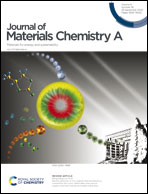Construction of a multi-interfacial-electron transfer scheme for efficient CO2 photoreduction: a case study using CdIn2S4 micro-flower spheres modified with Au nanoparticles and reduced graphene oxide†
Abstract
CdIn2S4 micro-flower spheres modified with Au NPs and rGO have been designed for CO2 photoreduction. The photoproduction yields of CO and CH4 were 4 and 5 times higher than that of pure CdIn2S4, respectively. The photoproduction of CO and CH4 from the photocatalytic CO2 reduction process has been evidenced by 13C isotope tracer tests. Au NPs act as both the acceptor of photogenerated electrons and the donor of hot electrons at the CdIn2S4 and rGO interface. Three electron transfer channels: CdIn2S4 → Au → rGO, CdIn2S4 → Au, and Au → rGO, efficiently improve the transfer efficiency of electrons. Meanwhile, CO2 adsorption is largely improved, as confirmed by DFT calculations which indicate that the CO2 adsorption ability of the C sites from rGO has been enhanced by Au NPs. In situ FTIR has been carried out to research the CO2 photoreduction process. This work demonstrates the importance of efficient electron transfer and excellent CO2 adsorption in improving the efficiency of CO2 photoreduction, providing an inspiring concept for future advancement in this area.



 Please wait while we load your content...
Please wait while we load your content...